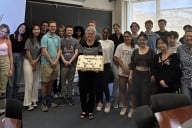You have /5 articles left.
Sign up for a free account or log in.
A new ruling from the United States Copyright Office that is making the rounds in higher education and blogosphere circles has a simple core meaning: fair use now applies to section 1200 of the DMCA, the anti-circumvention provision.
As far back as Princeton's Edward Felton's challenge to content owners from the computer science and engineering perspective and Berkeley's Pamela Samuelson from the legal arena, this question has remained open. Early to identify the issue and its potential deleterious effects that this unanswered question had on innovation and science, these academic leaders were soon supported by William Fisher, John Palfrey and William McGreveran. In a white paper they and others at the Berkman Center published in 2006,The Digital Learning Challenge, they specifically spoke to the effects that the absence of a clear ruling on this question was having on teaching and learning: for fear of violating copyright many film instructors, professors in other areas and students restricted their use of materials they believed to be in the service of fulfilling teaching missions.
The question, essentially, was: did the breaking of encryption on a DVD for a fair use of the content violate copyright law?
The answer is now "no." And that answer is a very good thing for higher education. With the uncertainty lifted, film studies professors -- or any instructors or students who wish to use encrypted digital materials -- may now do so without fear of litigation, so long as fair use covers the content.
That fair use of the content is still in play may delight or concern some people, depending on how one perceives fair use in higher education particularly or in American culture generally. For most of us, fair use remains an ambiguous legal principle critical to academia, especially as content owners have become more possessive extending term limits or threatening litigation for alleged copyright violations. Technology, of course, has disrupted laws and social norms more or less in balance as of middle of the last century.
Given the thoroughly integrated nature of technology in contemporary global education, the question of what is permissible use of copyright protected materials is a very critical one indeed. Moreover, because higher education is both a producer and consumer of content, it stands at the crossroads of an increasingly thorny issue in a global economy driven by the very matter of our enterprise: information.
One might suggest that for those very reasons higher education act as a leader in helping American and global society discuss and debate this issue for finer resolution in all four of the areas that influence our lives: technology, the market, social norms and the law. For some time now many people have rung the bell that a new balance in keeping with our prescient founder's goals of innovation and incentive be achieved among these areas and maintained with an eye specifically on how technology has changed the proverbial game.
The Copyright Office's ruling advances the ball down the field by a few important yards in a direction that complements academia and supporters of a culturally rich global civilization.
While it may not answer the myriad questions that remain about fair use, it at least addresses the basic matter of whether that principle applies to anti-circumvention in a way that allows instructors and students to work without fear to express themselves in creative fashion from remix to classroom instruction.
May higher education's contribution to this decision be the beginning of choice to assume leadership role in helping a global society remain dynamic, inventive and open.


